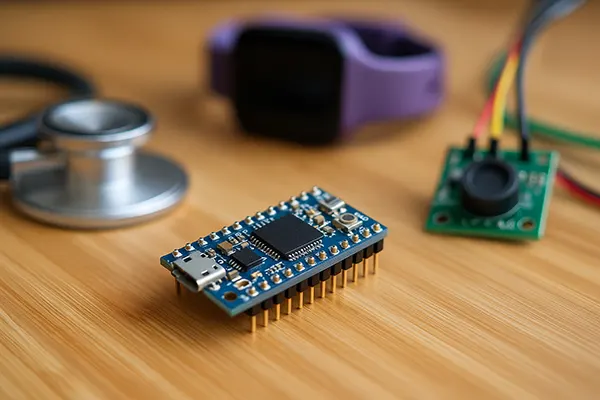
Neural Networks on the Edge: The Potential of TinyML for Education, Healthcare and IoT
TinyML – a branch of machine learning that focuses on deploying models directly on low-power microcontrollers – is changing how we interact with smart technology. In contrast to cloud-based AI, which requires constant internet connection and significant computational power, TinyML operates on the device itself. This means faster responses, lower energy consumption, and enhanced data privacy. As of 2025, we are witnessing rapid growth in real-world applications across sectors such as education, healthcare, and the Internet of Things (IoT).
Revolutionising Learning Environments
In educational settings, TinyML is being integrated into compact, affordable devices that allow students to interact with real-time data without relying on external servers. These applications bring abstract concepts in AI and computing to life, making technical education more accessible and engaging.
Schools and universities are using microcontroller-based kits with embedded models to teach coding, data science, and algorithm design. This hands-on approach enables learners to see immediate outcomes from their code, fostering creativity and experimentation.
Moreover, educators benefit from adaptive learning environments powered by TinyML. These systems can track classroom behaviour, optimise lighting or sound conditions, and provide insights into student engagement – all processed locally to protect privacy.
Promoting Equity Through Technology Access
One of the most transformative aspects of TinyML in education is its cost-efficiency. Devices such as Arduino Nano or Raspberry Pi Pico cost under €10, yet they can run powerful inference models. This affordability empowers schools in low-income areas to integrate AI learning into their curriculum.
Through global outreach initiatives and open-source software, educational institutions in developing regions are gaining access to the same tools as their counterparts in wealthier nations. This helps bridge the digital divide and prepares a more diverse generation of students for the tech-driven future.
Furthermore, the simplicity of TinyML hardware makes it ideal for early learners and hobbyists. Students can build intelligent systems such as gesture recognisers, voice assistants, or environmental sensors using minimal resources, fostering both technical and problem-solving skills from an early age.
Enhancing Diagnostics and Monitoring in Healthcare
In 2025, healthcare providers are increasingly turning to TinyML for solutions that improve diagnostic speed, reduce costs, and preserve patient privacy. With medical-grade sensors connected to microcontrollers, real-time data analysis can occur at the point of care, without needing to transmit sensitive information to the cloud.
Applications include wearable devices that detect irregular heartbeats, monitor glucose levels, or recognise falls in elderly patients. These systems alert caregivers or physicians only when anomalies are detected, reducing false positives and healthcare burden.
Another area of growth is remote patient monitoring. TinyML-enabled devices are used to track patient vitals at home, facilitating chronic disease management without overwhelming clinical infrastructure. Since processing happens locally, there’s no risk of data leakage over networks.
Precision Medicine with Local Intelligence
TinyML also plays a key role in tailoring treatment plans through real-time feedback. Devices can analyse how a patient responds to medication or therapy and make micro-adjustments to optimise outcomes. This creates a feedback loop that enhances precision medicine without constant clinical oversight.
For instance, prosthetics with embedded TinyML systems can adapt to the gait or muscle tension of users, offering more natural mobility and reducing long-term complications. Similarly, drug-dispensing inhalers for asthma now include on-device analytics to track dosage effectiveness.
Furthermore, medical research benefits from portable diagnostic kits built on TinyML frameworks. In field conditions or underserved regions, these tools enable on-site analysis of samples without waiting for lab-based confirmations, accelerating response time during outbreaks or emergencies.

Scaling Smart IoT Infrastructures
The Internet of Things is no longer just about connectivity – it’s about intelligence at the edge. With over 50 billion devices projected to be connected globally by the end of 2025, TinyML becomes critical to managing the data generated by this vast ecosystem without overwhelming networks or cloud resources.
Smart home devices now incorporate TinyML to enable voice and motion recognition, anomaly detection, or environment sensing. Since inference happens locally, users experience faster reaction times, reduced dependency on the internet, and greater privacy control.
Industrial IoT is another domain where TinyML is accelerating adoption. Manufacturing equipment fitted with smart sensors can predict mechanical failures, optimise energy consumption, or detect quality deviations during production – all with minimal latency and without interrupting operations.
Energy Efficiency and Sustainable Development
A major advantage of TinyML in IoT systems is its low power footprint. These devices often run on coin-cell batteries for months or even years. This opens up use cases in remote locations, where regular maintenance or electricity access is limited.
For example, environmental monitoring in agriculture now uses TinyML sensors to analyse soil health, temperature, and moisture in real-time, ensuring sustainable farming practices. Forest fire detection systems equipped with edge models are already deployed in regions such as Australia and California, providing early warnings without relying on satellite links.
Finally, city infrastructure benefits from TinyML-powered traffic systems, smart lighting, and air quality monitors. These contribute to urban sustainability goals by reducing emissions, improving efficiency, and reacting autonomously to real-world conditions.
